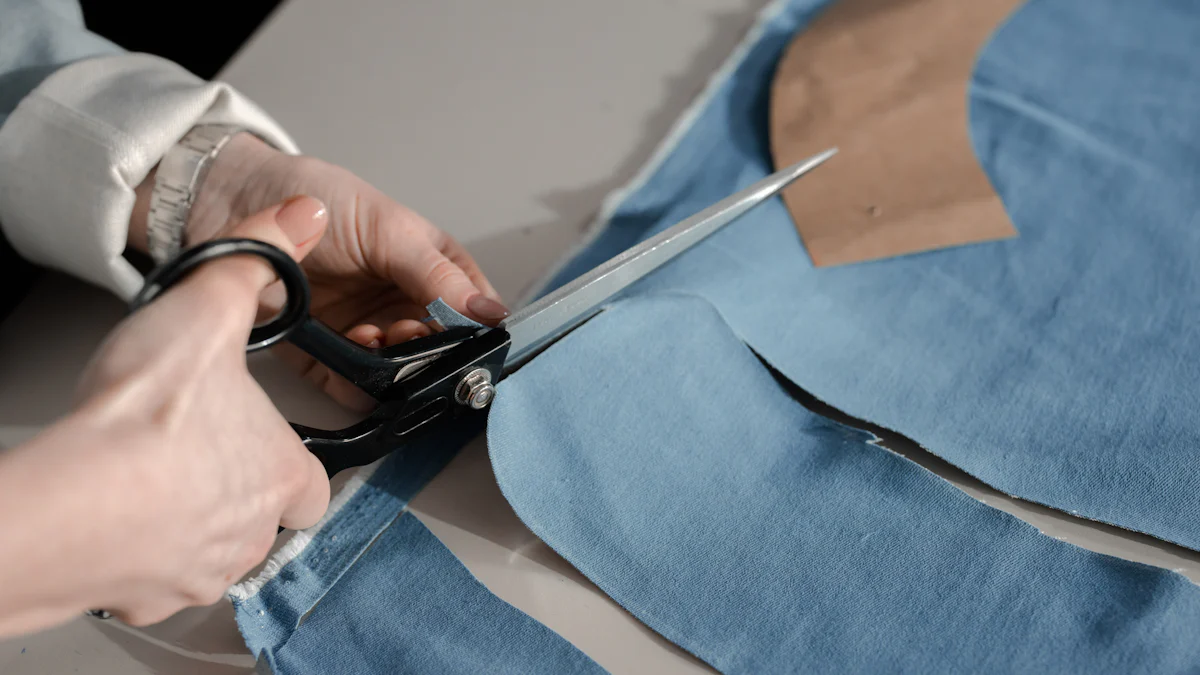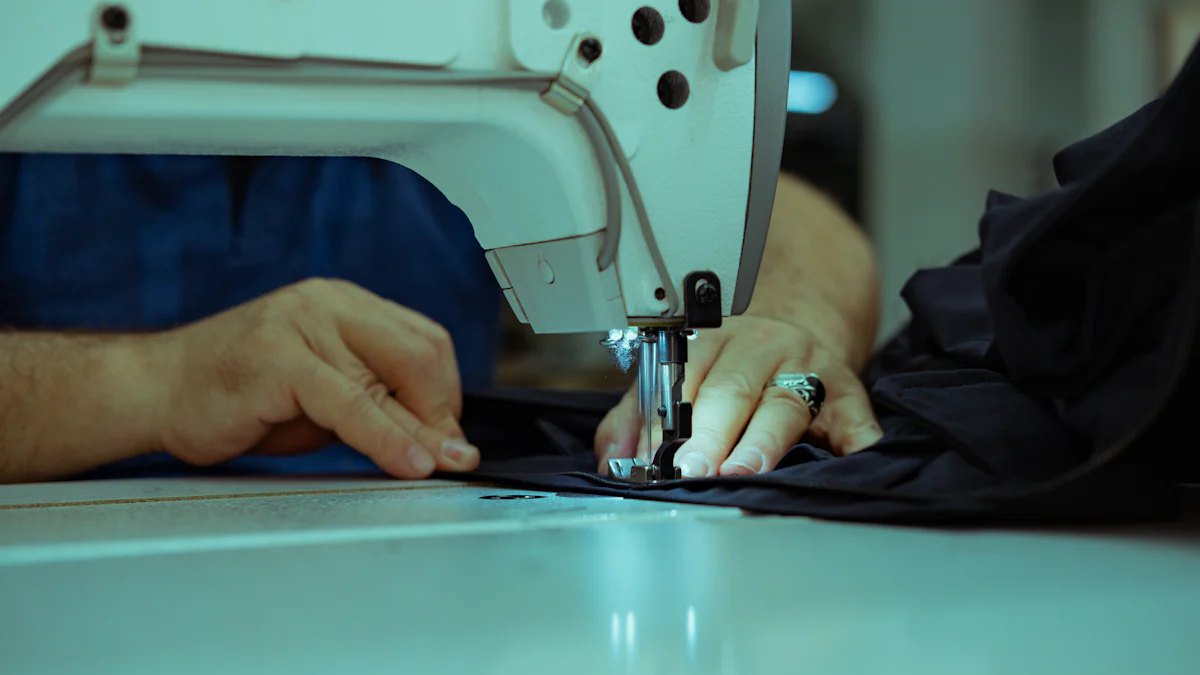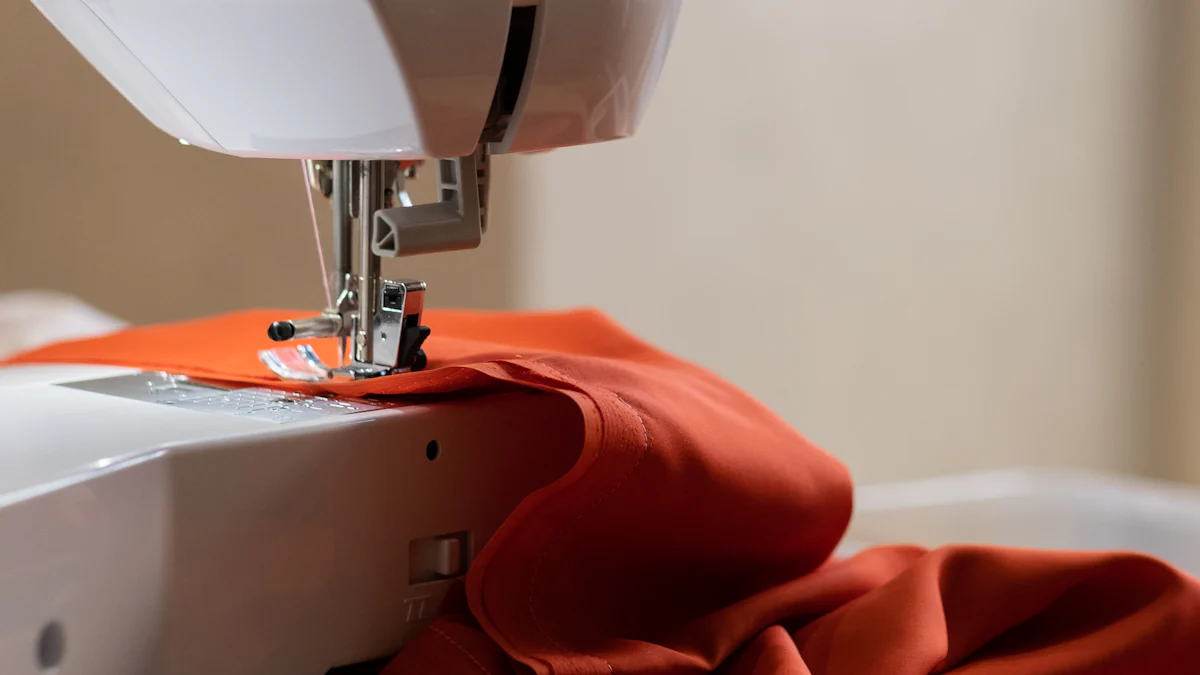Pros and Cons of DE TECH Cloth Cutting Machines

In the fabric industry, precision and efficiency are essential for success. A de tech cloth cutting machine offers a modern solution to meet these demands. These machines excel in delivering rapid and accurate fabric cutting, which can significantly enhance production quality. Unlike manual methods, they allow you to cut fabrics up to six times faster while maintaining consistency. Their ability to handle complex designs and large-scale operations makes them indispensable for businesses aiming to stay competitive. By understanding their strengths and limitations, you can make informed decisions that align with your production goals.
Key Takeaways
DE TECH cloth cutting machines enhance production efficiency by cutting fabric up to six times faster than manual methods, ensuring high-quality results. These machines offer unmatched precision and accuracy, reducing material waste and aligning perfectly with design specifications.
- Investing in DE TECH machines can lead to long-term cost savings by minimizing labor expenses and maximizing fabric utilization.
- While the initial investment is high, the benefits of speed, accuracy, and versatility can significantly outweigh the costs for larger operations.
- Small businesses should carefully assess their production needs and budget, as the complexity and cost of DE TECH machines may not be suitable for low-volume operations.
- Regular maintenance is crucial to ensure optimal performance and longevity of the machines, preventing costly disruptions in production.
- Consider hybrid approaches that combine manual and automated cutting methods to balance cost and efficiency, especially for businesses transitioning to automation.
Overview of DE TECH Cloth Cutting Machines
Key Features of DE TECH Cloth Cutting Machines
A de tech cloth cutting machine stands out due to its advanced features that cater to modern fabric production needs. These machines use computer-controlled technology to deliver precise and efficient fabric cutting. You can rely on their ability to handle intricate patterns and designs with unmatched accuracy. The integration of advanced software allows you to create, modify, and execute designs seamlessly, which enhances both creativity and productivity.
Another notable feature is their speed. These machines cut fabric much faster than traditional methods, enabling you to meet tight deadlines without compromising quality. They also support a wide range of fabric types, from delicate silks to heavy-duty materials, ensuring versatility in your operations. Additionally, their automated systems reduce manual intervention, minimizing errors and ensuring consistency across production batches.
Common Applications in the Fabric Industry
DE TECH cloth cutting machines have become indispensable in various sectors of the fabric industry. In garment manufacturing, these machines play a crucial role in cutting fabric layers with precision, which is essential for producing high-quality clothing. You can also find them in upholstery production, where they handle thick and durable materials used for furniture and automotive interiors.
In the fashion industry, these machines enable designers to bring complex and creative patterns to life. Their ability to cut intricate shapes and designs makes them ideal for creating unique garments and accessories. Furthermore, they are widely used in mass production settings, where speed and accuracy are critical for meeting large-scale demands.
"Fabric cutting is the most important step in garment manufacturing technology." This statement highlights the significance of using reliable tools like DE TECH cloth cutting machines to ensure efficiency and precision in this vital process.
By incorporating these machines into your operations, you can streamline production, reduce waste, and achieve consistent results, regardless of the complexity or scale of your projects.
Advantages of Using DE TECH Cloth Cutting Machines

Precision and Accuracy
A de tech cloth cutting machine delivers unmatched precision in fabric cutting. You can rely on its computer-controlled technology to execute intricate patterns and designs with absolute accuracy. This precision ensures that every cut aligns perfectly with your design specifications, reducing errors and material waste. Whether you work with delicate fabrics or heavy-duty materials, these machines maintain consistent results across all projects. By using this technology, you enhance the quality of your products and meet the high standards expected in the fabric industry.
Time and Labor Efficiency
Time is a critical factor in fabric production, and a de tech cloth cutting machine helps you save plenty of it. These machines operate at remarkable speeds, cutting fabric layers much faster than manual methods. This efficiency allows you to complete large-scale projects within tight deadlines. Additionally, the automation reduces the need for manual labor, freeing up your workforce for other essential tasks. By integrating these machines into your operations, you streamline production processes and boost overall productivity.
Versatility in Handling Different Fabrics
A de tech cloth cutting machine adapts to various fabric types, making it a versatile tool for your business. From soft silks to thick upholstery materials, these machines handle a wide range of textiles with ease. You can switch between different fabric types without compromising on precision or speed. This versatility proves invaluable in industries like fashion, upholstery, and garment manufacturing, where diverse materials are often used. By investing in this technology, you gain the flexibility to meet the demands of multiple projects and expand your production capabilities.
Long-Term Cost-Effectiveness
Investing in a de tech cloth cutting machine can lead to significant long-term savings for your business. While the initial purchase cost may seem high, the machine's efficiency and durability offset this expense over time. By automating the fabric cutting process, you reduce material waste caused by human error. Precise cuts ensure that every inch of fabric is utilized effectively, which lowers your overall material costs.
These machines also minimize labor expenses. Automation reduces the need for a large workforce to handle cutting tasks. You can allocate your team to other critical areas of production, improving overall operational efficiency. Additionally, the machine's speed allows you to complete more projects in less time, increasing your output and revenue potential.
Maintenance costs for these machines are manageable when you follow proper care routines. Regular servicing ensures optimal performance and extends the machine's lifespan. This reliability means fewer disruptions to your production schedule, saving you money on unexpected repairs or downtime.
In industries where precision and speed are essential, the long-term benefits of these machines outweigh the upfront investment. By incorporating this technology into your operations, you position your business for sustained growth and profitability.
Disadvantages of Using DE TECH Cloth Cutting Machines
High Initial Investment
Purchasing a de tech cloth cutting machine requires a significant upfront cost. This high initial investment can pose a challenge, especially for small businesses or startups with limited budgets. The advanced technology and precision these machines offer come at a premium price. While the long-term benefits may outweigh the expense, the initial financial burden can deter many from adopting this technology. For businesses operating on tight margins, allocating funds for such a purchase might feel risky without guaranteed returns.
Additionally, the cost doesn’t stop at the machine itself. You may need to invest in compatible software, training for your team, and possibly upgrading your workspace to accommodate the equipment. These additional expenses can further increase the financial strain, making it essential to carefully evaluate your production needs and budget before committing to this investment.
Complexity and Learning Curve
Operating a de tech cloth cutting machine involves mastering its advanced features and software. If you or your team lack experience with computerized cutting technology, the learning curve can feel steep. The machine’s complexity may initially slow down your production as you adapt to its functions and capabilities. This adjustment period can lead to inefficiencies, especially if you’re working on tight deadlines.
Training is crucial to overcome this challenge, but it requires time and resources. You may need to hire experts or enroll your team in specialized training programs to ensure they can operate the machine effectively. Without proper training, mistakes can occur, leading to wasted materials and delays in production. The complexity of these machines makes it vital to plan for a transition period when integrating them into your operations.
Maintenance and Technical Issues
Regular maintenance is essential to keep a de tech cloth cutting machine running smoothly. Neglecting upkeep can result in performance issues, which may disrupt your production schedule. You must allocate time and resources for routine servicing to ensure the machine operates at its best. Maintenance costs, while manageable, can add up over time, especially if repairs or replacement parts are needed.
Technical issues can also arise, particularly if the machine is used extensively or improperly. Resolving these problems often requires professional assistance, which can lead to additional expenses and downtime. For businesses that rely heavily on uninterrupted production, these disruptions can impact overall efficiency and profitability. Ensuring your team understands the machine’s maintenance requirements and troubleshooting procedures is critical to minimizing these risks.
"Organizations that applied AI and automation to security prevention saw the biggest impact in reducing the cost of a breach." Similarly, investing in regular maintenance and technical support for automated systems like cloth cutting machines can prevent costly breakdowns and ensure consistent performance.
By understanding these potential drawbacks, you can prepare for the challenges and make informed decisions about whether this technology aligns with your business goals.
Limited Suitability for Small-Scale Operations
A DE TECH cloth cutting machine may not be the best fit for small-scale operations. The high upfront cost can strain your budget if your production volume is low. For small businesses, the return on investment might take longer to realize, making it a less practical choice. You need to carefully assess whether the machine's capabilities align with your production needs.
The size and complexity of these machines also pose challenges for smaller setups. They require adequate space and infrastructure, which might not be available in a small workshop. Additionally, the advanced features of the machine may remain underutilized if your projects do not demand intricate designs or high-speed cutting. This underuse could lead to inefficiencies and wasted potential.
Automation, while beneficial for large-scale operations, might not always suit smaller businesses. Manual cutting methods or simpler tools often provide more flexibility for custom or low-volume orders. These alternatives allow you to adapt quickly to changing demands without the need for extensive training or maintenance.
"Organizations that applied AI and automation to security prevention saw the biggest impact in reducing the cost of a breach." Similarly, automation in fabric cutting offers significant advantages for large-scale operations. However, for small-scale setups, the benefits may not outweigh the costs and complexities involved.
If you operate a small business, consider your production scale, budget, and specific needs before investing in a DE TECH cloth cutting machine. Exploring other cutting methods might provide a more cost-effective and practical solution for your operations.
Comparison with Other Cutting Methods

Manual Cutting Methods
Manual cutting methods rely on hand tools like scissors or rotary cutters. These tools offer simplicity and affordability, making them accessible for small-scale operations or beginners. You can easily adapt manual cutting to custom designs or low-volume projects. This flexibility proves useful when working on unique or intricate patterns that require a personal touch.
However, manual cutting has limitations. It demands significant time and effort, especially for large-scale production. The process often results in inconsistencies due to human error, which can lead to material waste. Labor costs also increase as more workers are needed to meet production demands. While manual methods suit small businesses or hobbyists, they struggle to match the precision and efficiency of automated solutions. cutting methods suit small businesses or hobbyists, they struggle to match the precision and efficiency of automated solutions.
"The maintenance cost is high. Labor cost is high. Expensive method." This statement highlights the challenges of relying solely on manual labor for fabric cutting, especially in industries where speed and accuracy are critical.
Other Automated Cutting Machines
Automated cutting machines, apart from the de tech cloth cutting machine, include laser cutters, die cutters, and waterjet cutters. These machines excel in specific applications. For instance, laser cutters provide exceptional precision for intricate designs, while waterjet cutters handle thick or layered materials effectively. Die cutters work well for repetitive patterns in mass production.
Each type of automated machine has its strengths and weaknesses. Laser cutters, though precise, may struggle with certain fabric types due to heat damage. Waterjet cutters require significant maintenance and consume large amounts of water. Die cutters lack versatility, as they are limited to pre-designed templates. These machines often involve high initial costs, similar to the de tech cloth cutting machine, but their specialized capabilities make them valuable in specific industries.
When comparing these machines, you should consider your production needs. If versatility and adaptability are priorities, the de tech cloth cutting machine offers a balanced solution. Its ability to handle various fabrics and designs makes it a practical choice for diverse operations. cutting methods makes it a practical choice for diverse operations.
Hybrid Approaches
Hybrid approaches combine manual and automated methods to achieve a balance between cost and efficiency. For example, you might use manual cutting for prototypes or custom orders while relying on automated machines for bulk production. This strategy allows you to maximize the strengths of both methods.
Hybrid approaches work well for businesses transitioning to automation. You can gradually integrate automated machines into your workflow without completely abandoning manual techniques. This flexibility helps you manage costs and adapt to changing production demands. However, hybrid methods require careful planning to ensure smooth coordination between manual and automated processes.
By adopting a hybrid approach, you gain the ability to scale your operations while maintaining the personal touch of manual cutting. This strategy proves especially useful for small businesses looking to expand without overextending their resources.
A DE TECH cloth cutting machine offers significant advantages, such as precision, efficiency, and versatility. These benefits can transform your production process and improve overall output. However, the high initial cost and complexity may pose challenges, especially for small-scale operations. You should carefully evaluate your production needs, budget, and long-term goals before making a decision. By weighing the pros and cons, you can determine if this technology aligns with your business objectives. Investing in the right tools ensures that your operations remain competitive and efficient in the evolving fabric industry.
FAQ
What makes DE TECH cloth cutting machines different from manual methods?
DE TECH cloth cutting machines provide precise and consistent cuts by using advanced computer-controlled technology. Manual methods, like scissors or rotary cutters, often result in inconsistencies due to human error. These machines also allow you to use templates for intricate designs, which is challenging to achieve manually. Additionally, DE TECH machines operate much faster, saving you time and effort.
Are DE TECH cloth cutting machines suitable for all types of fabrics?
Yes, these machines are highly versatile. They can handle a wide range of fabrics, from delicate silks to heavy-duty materials like denim or upholstery fabric. The advanced software ensures that you can adjust settings to suit the specific requirements of each material, maintaining precision and quality.
How do DE TECH machines compare to other automated cutting machines?
While laser cutters excel in intricate designs and waterjet cutters handle thick materials, DE TECH machines adapt to various fabrics and designs with ease.
Is the initial cost of a DE TECH machine worth it?
The upfront cost may seem high, but the long-term benefits often outweigh the expense. These machines reduce material waste, save labor costs, and increase production speed. Over time, the efficiency and durability of DE TECH machines can lead to significant savings, making them a valuable investment for businesses focused on growth.
Do I need special training to operate a DE TECH cloth cutting machine?
Yes, some training is necessary to understand the machine's features and software. However, most manufacturers provide user-friendly guides and training programs to help you and your team get started. With proper training, you can quickly overcome the learning curve and maximize the machine's potential.
How much maintenance does a DE TECH machine require?
Regular maintenance is essential to keep the machine running smoothly. This includes cleaning, software updates, and occasional servicing. Following the manufacturer's guidelines ensures optimal performance and extends the machine's lifespan. Proper care minimizes downtime and prevents costly repairs.
Can small businesses benefit from DE TECH cloth cutting machines?
Small businesses can benefit if their production volume justifies the investment. For low-scale operations, the high initial cost and advanced features might not be fully utilized. In such cases, manual methods or hybrid approaches may prove more practical. However, for growing businesses, these machines can streamline processes and improve output quality.
What are the limitations of DE TECH cloth cutting machines?
The primary limitations include the high initial cost and the need for adequate space and infrastructure. Additionally, the complexity of the machine may require time and resources for training. Small-scale operations might find these machines less suitable due to underutilization of their advanced features.
How do hybrid approaches work with DE TECH machines?
Hybrid approaches combine manual and automated methods. You can use DE TECH machines for bulk production while relying on manual cutting for custom or low-volume orders. This strategy allows you to balance cost and efficiency, making it ideal for businesses transitioning to automation.
Are DE TECH machines environmentally friendly?
These machines reduce fabric waste by ensuring precise cuts, which contributes to sustainability. However, their energy consumption depends on the model and usage. By following energy-efficient practices and maintaining the machine properly, you can minimize its environmental impact.
See Also
Advantages and Disadvantages of Cricut Machines for Plastic
Cost and Varieties of Cutting Machines Explained
Understanding Cutting Machines and Their Various Applications
